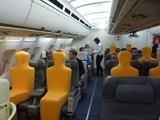Custom-controlled climate on airplanes
30 Aug 2012
The indoor climate on airplanes is a frequent source of complaints. In the future, passengers should be able to set their own individualised climate and temperature controls and also be able to adjust air supply to their own personal preference. At the ILA Berlin Air Show from 11 to 16 September, among other things, researchers will be presenting an airplane seat that is able to provide for these settings.
 |
| In each of three different „flights'' test subjects could attain their personalized indoor climate settings. © Fraunhofer IBP |
Start your vacation as soon as you walk into the airplane. But the indoor environment inside these metal birds often leaves much to be desired: while it's too cold for him, it's too dry for her; is there more fresh air, and can you make it cooler? Also the low humidity may still cause dissatisfaction among several passengers.
This may all change in the future. Until now, indoor climate could only be set by the main controls, but soon, the passenger will be able to modulate it individually – from the temperature, to the speed at which fresh air flows in, and even the humidity in the air. Because the temperature and humidity that different people find comfortable varies widely.
More comfort through seat heating and ventilation, and adjustable air supply
The technologies that are needed for this purpose are currently being developed by the researchers at the Fraunhofer Institute for Building Physics IBP in Valley, working in a consortium – together with nine partners from universities and the aviation industry – through iSPACE, a project funded by the EC.
All that you need to regulate indoor climate individually, explains Dr. Gunnar Grün, head of department ''indoor climate'' at IBP: ''You need various components that we engineered within the consortium. Humidifier units deliver greater humidity; air purifier technologies filter unwanted substances from the air; optimised vents allow fresh air to flow in, and the passengers can set their own personal comfort temperatures through the seat heaters, just like the ones we find in cars today. And there is seat ventilation that draws in heat and moisture between body and seat, thus keeping the seat comfortably cool.''
Fraunhofer researchers have devoted their attention primarily to the supply of fresh air. Until now, passengers could only manipulate an air jet in the ceiling. The majority of passengers shut these off right when the flight begins, because it blows air directly onto their heads, creating heavy drafts and additional noise.






















